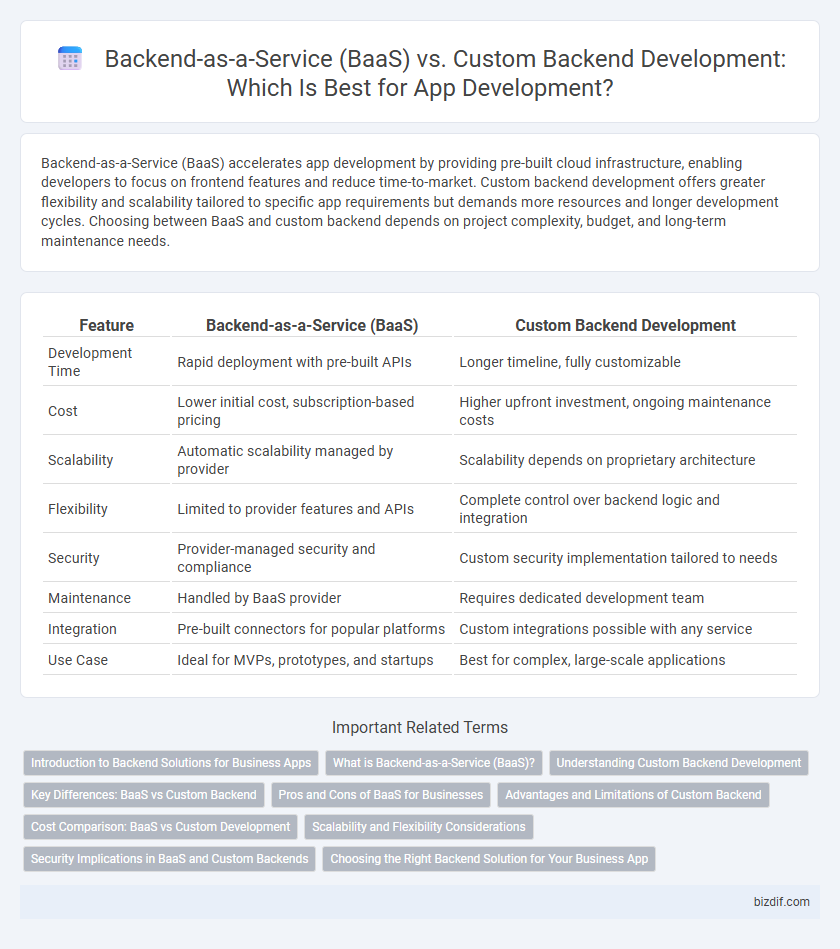Backend-as-a-Service (BaaS) accelerates app development by providing pre-built cloud infrastructure, enabling developers to focus on frontend features and reduce time-to-market. Custom backend development offers greater flexibility and scalability tailored to specific app requirements but demands more resources and longer development cycles. Choosing between BaaS and custom backend depends on project complexity, budget, and long-term maintenance needs.
Table of Comparison
| Feature | Backend-as-a-Service (BaaS) | Custom Backend Development |
|---|---|---|
| Development Time | Rapid deployment with pre-built APIs | Longer timeline, fully customizable |
| Cost | Lower initial cost, subscription-based pricing | Higher upfront investment, ongoing maintenance costs |
| Scalability | Automatic scalability managed by provider | Scalability depends on proprietary architecture |
| Flexibility | Limited to provider features and APIs | Complete control over backend logic and integration |
| Security | Provider-managed security and compliance | Custom security implementation tailored to needs |
| Maintenance | Handled by BaaS provider | Requires dedicated development team |
| Integration | Pre-built connectors for popular platforms | Custom integrations possible with any service |
| Use Case | Ideal for MVPs, prototypes, and startups | Best for complex, large-scale applications |
Introduction to Backend Solutions for Business Apps
Backend-as-a-Service (BaaS) provides pre-built backend infrastructure, enabling rapid app development with features like user authentication, databases, and cloud storage managed by third-party providers. Custom backend development offers tailored solutions designed to meet specific business requirements, allowing full control over performance, scalability, and security. Choosing between BaaS and custom backend development depends on factors such as development speed, budget constraints, and the need for customization in business applications.
What is Backend-as-a-Service (BaaS)?
Backend-as-a-Service (BaaS) is a cloud-based solution that provides developers with ready-to-use backend infrastructure, including databases, authentication, cloud storage, and server-side logic. It enables rapid app development by abstracting complex backend management, allowing teams to focus on frontend functionality and user experience. Popular BaaS providers like Firebase, AWS Amplify, and Parse offer scalable, secure, and real-time capabilities essential for modern app development.
Understanding Custom Backend Development
Custom backend development offers tailored server-side solutions designed specifically to meet complex application requirements, ensuring full control over data management, security protocols, and business logic. This approach supports scalability and flexibility by allowing developers to optimize architecture for unique performance needs and integrate with specialized APIs or legacy systems. Unlike Backend-as-a-Service (BaaS), custom backend development demands more time and resources but provides unparalleled customization and ownership of the backend infrastructure.
Key Differences: BaaS vs Custom Backend
Backend-as-a-Service (BaaS) offers pre-built backend infrastructure, enabling rapid app development with features like authentication, databases, and cloud storage managed by third-party providers. Custom backend development provides complete control and flexibility, allowing tailored architectures and optimized performance to meet specific application requirements. Choosing between BaaS and custom backend depends on factors such as scalability needs, development timeline, maintenance resources, and long-term cost efficiency.
Pros and Cons of BaaS for Businesses
Backend-as-a-Service (BaaS) offers rapid deployment and reduces the need for extensive backend infrastructure management, making it ideal for startups and small businesses with limited resources. However, reliance on BaaS providers can lead to vendor lock-in, potential scalability limitations, and less control over data security and customization. Businesses must weigh the trade-offs between development speed and flexibility when choosing between BaaS and custom backend development.
Advantages and Limitations of Custom Backend
Custom backend development allows for tailored functionality and full control over the application's architecture, enabling optimized performance and scalability specific to business needs. It ensures enhanced security management by implementing customized protocols, though it requires significant time and resources for development, testing, and maintenance. Unlike Backend-as-a-Service (BaaS), custom backends offer greater flexibility but demand skilled developers and ongoing infrastructure management.
Cost Comparison: BaaS vs Custom Development
Backend-as-a-Service (BaaS) significantly reduces upfront costs by offering ready-made infrastructure and maintenance, allowing developers to avoid expenses related to server management and backend coding. Custom backend development incurs higher initial investments due to the need for designing, coding, testing, and deploying tailored solutions, along with ongoing maintenance costs and potential scalability challenges. Over time, BaaS can provide better cost efficiency for small to medium apps, while custom development may offer long-term savings for complex, large-scale projects requiring unique backend functionality.
Scalability and Flexibility Considerations
Backend-as-a-Service (BaaS) platforms offer rapid scalability through pre-built infrastructure and automatic resource management, ideal for startups or projects with fluctuating user demand. Custom backend development provides greater flexibility to tailor architecture, optimize performance, and implement unique business logic, supporting complex scalability requirements and long-term growth strategies. Evaluating the trade-offs between the ease of scaling with BaaS and the control afforded by custom solutions is critical for aligning backend development with specific app scalability and flexibility goals.
Security Implications in BaaS and Custom Backends
Backend-as-a-Service (BaaS) platforms offer built-in security features such as encryption, authentication, and compliance certifications, reducing the burden on developers to implement robust protections. Custom backend development allows for tailored security measures specifically designed to meet unique application requirements, but it demands specialized expertise and ongoing maintenance to address evolving threats. Evaluating security implications involves considering the trade-offs between standardized, managed security in BaaS and customizable, granular control in custom backends.
Choosing the Right Backend Solution for Your Business App
Backend-as-a-Service (BaaS) offers pre-built infrastructure and APIs that accelerate app development with scalable, cloud-based solutions, ideal for startups and projects requiring rapid deployment. Custom backend development provides tailored architectures optimized for specific business logic, enhanced security, and greater control, suitable for enterprises with complex workflows and long-term scalability needs. Selecting the right backend depends on factors like development speed, budget, scalability requirements, and maintenance capabilities aligned with your business objectives.
Backend-as-a-Service (BaaS) vs Custom Backend Development Infographic

 bizdif.com
bizdif.com